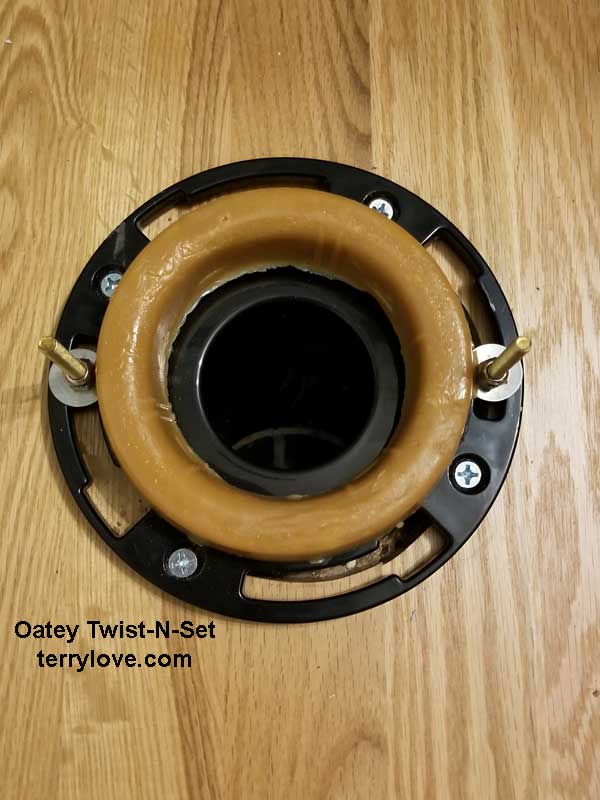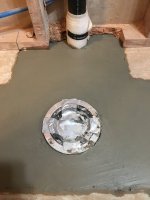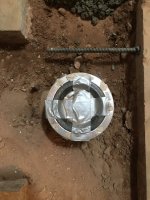Building a new bathroom, plumber left the rough-in for the toilet with this closet flange like this. I don't know how to pour the concrete around this. Should I cut the flange out, pour, then come back and install the flange after tiling?
You are using an out of date browser. It may not display this or other websites correctly.
You should upgrade or use an alternative browser.
You should upgrade or use an alternative browser.
Closet Flange Rough-In Before Pouring Concrete
- Thread starter jmpadil3
- Start date
Users who are viewing this thread
Total: 2 (members: 0, guests: 2)
Put some putty where the slots are so that the closet bolts can be installed later and then pour the concrete.
Sponsor
Paid Advertisement
Building a new bathroom, plumber left the rough-in for the toilet with this closet flange like this. I don't know how to pour the concrete around this. Should I cut the flange out, pour, then come back and install the flange after tiling?
I don't follow... Do I put the putty on the top or underside of the flange? The entire circumference of the flange or just where the holes are? How do I remove the putty after the concrete is placed? Do I screed right up to the bottom lip of the flange, or do I want concrete underneath the flange?
The putty is so that the closet bolts can be installed later without chipping out concrete. You can leave the putty there. It's only for the slot that holds the closet bolts.
The concrete should be poured level or the floor will be uneven and the bowl will need to be shimmed.

The concrete should be poured level or the floor will be uneven and the bowl will need to be shimmed.

Plumber69
In the Trades
I always run 4" pipe up. And use a flush fitt flange that glues inside the 4 inch pipe after tiling.
hj
Master Plumber
- Messages
- 33,603
- Reaction score
- 1,042
- Points
- 113
- Location
- Cave Creek, Arizona
- Website
- www.terrylove.com
quote;
I always run 4" pipe up. And use a flush fitt flange that glues inside the 4 inch pipe after tiling.
Interesting, because while I always run the 4" pipe up, I NEVER use an "inside" flange, unless it is to repair an outside one which has deteriorated because of improper installation.
I always run 4" pipe up. And use a flush fitt flange that glues inside the 4 inch pipe after tiling.
Interesting, because while I always run the 4" pipe up, I NEVER use an "inside" flange, unless it is to repair an outside one which has deteriorated because of improper installation.
quote;
I always run 4" pipe up. And use a flush fitt flange that glues inside the 4 inch pipe after tiling.
Interesting, because while I always run the 4" pipe up, I NEVER use an "inside" flange, unless it is to repair an outside one which has deteriorated because of improper installation.
This looks like a 3” street elbow with the flange glued over. Is this common to glue the flange on before pouring concrete? The prep work before concrete just seems like more of a hassle.
Did the plumber tell you that the flange was glued in place already?Building a new bathroom, plumber left the rough-in for the toilet with this closet flange like this.
Did the plumber tell you that the flange was glued in place already?
No.
I would try some tugging and rocking with one hand while countering the force on the elbow with the other.
I am hoping the plumber just plugged the fitting with the unglued flange for now. I don't know how tight a spigot toilet flange would be just pressed in, but I am suspecting it could be significant.
If you can see glue oozing out using a mirror, it was glued, but I suspect most glue jobs don't ooze enough to see in your situation. I am not a plumber, and I have never installed a closet flange.
Last edited:
I would try some tugging and rocking with one hand while countering the force on the elbow with the other.
I am hoping the plumber just plugged the fitting with the unglued flange for now. I don't know how tight a spigot toilet flange would be just pressed in, but I am suspecting it could be significant.
If you can see glue oozing out using a mirror, it was glued, but I suspect most glue jobs don't ooze enough to see in your situation. I am not a plumber, and I have never installed a closet flange.
I'll give what you're describing a try. I popped open the tab and thought I saw some glue resin on the diameter seams. Sounds like you're also suggesting this is not a common practice.
If you pulled the test cap on that Proflow Push N’ Peel Closet Flange, and saw glue, then it is glued.I'll give what you're describing a try. I popped open the tab and thought I saw some glue resin on the diameter seams. Sounds like you're also suggesting this is not a common practice.
I would like to hope it is not a very common practice, but I have no relevant experience. Nobody seemed shocked. Now that I think of it, it is probably better with to-be-poured concrete than with wood. You could work some concrete or mortar under during the pour. That putty thing sounds brilliant. Putty on the screw holes would be good too. Maybe you could attach lead anchors to the flange with somewhat loose screws before the floor is poured rather than drilling and using concrete screws after the concrete hardens. Something might be done to allow the screw to be tightened into the anchor later. Maybe some putty around threads could reserve space for that.
Last edited:
Plumber69
In the Trades
I get perfect flange height ever time this wayquote;
I always run 4" pipe up. And use a flush fitt flange that glues inside the 4 inch pipe after tiling.
Interesting, because while I always run the 4" pipe up, I NEVER use an "inside" flange, unless it is to repair an outside one which has deteriorated because of improper installation.
Last edited by a moderator:
As does hj, as long as the floor is in place before he glues the flange.I get perfect flange height ever time this way
Jadnashua
Retired Defense Industry Engineer xxx
There's a functional advantage to using 4" and an inside mount flange...you can tile tight up against the outside of the pipe, then cut it off after and be able to mount the flange. When using a flange with a socket, you have to leave room around the pipe to insert the flange. Either can work. WHen pouring the concrete, you can leave a sleeve around the pipe to give you the clearance needed, but you also then have to be more accurate when cutting and setting your tile. Easier to forget both of those things IF you have a 4" pipe.
Make sure that the pipe is braced so that the flange will end up being level, or you'll have other issues. It's easy to move it out of whack when pouring the concrete, and once it cures, you're stuck.
Make sure that the pipe is braced so that the flange will end up being level, or you'll have other issues. It's easy to move it out of whack when pouring the concrete, and once it cures, you're stuck.
Kreemoweet
In the Trades
Installing toilet flanges before the concrete is poured, is unfortunately very common, because in some areas the plumbing
inpectors insist on it. It makes the whole deal 10 times harder. The concrete crew will make a mess of things 9 times out of 10
inpectors insist on it. It makes the whole deal 10 times harder. The concrete crew will make a mess of things 9 times out of 10
Jadnashua
Retired Defense Industry Engineer xxx
My preference would be to make the stubout much taller than needed and put a cap on it so it can be tested. Then, cut it off where needed after the finished floor is done to install the flange. But, that takes a bit more materials, but saves a lot of time.
Puttied over the screw holes and flange bolt holes. Also made sure no paste adhered to the edges so the flange ring can still spin freely. Pictures are pre and post pour. Good to see some pro opinions on the flange sequence, I suspected it would be a concern. Most of my experience is from civil construction, so having done a lot of concrete pours I know that embeds, etc always get knocked around.
Attachments
Similar threads
- Replies
- 2
- Views
- 295
- Replies
- 14
- Views
- 292
- Replies
- 7
- Views
- 458
- Replies
- 0
- Views
- 107
- Replies
- 8
- Views
- 286




